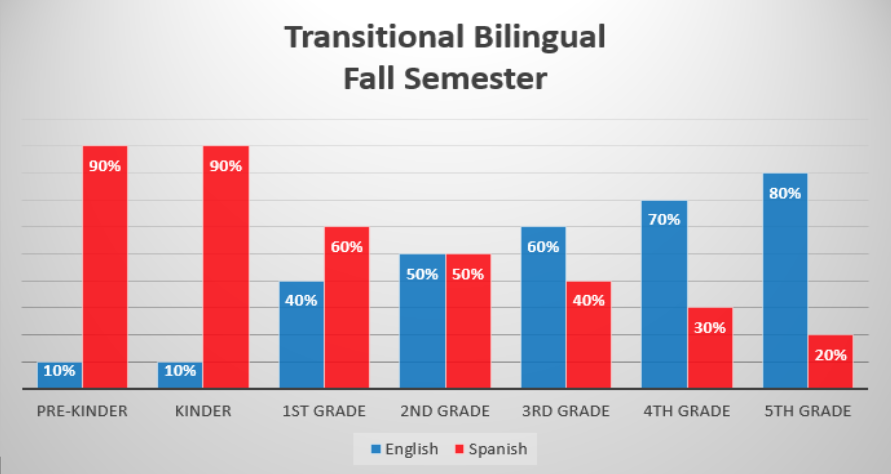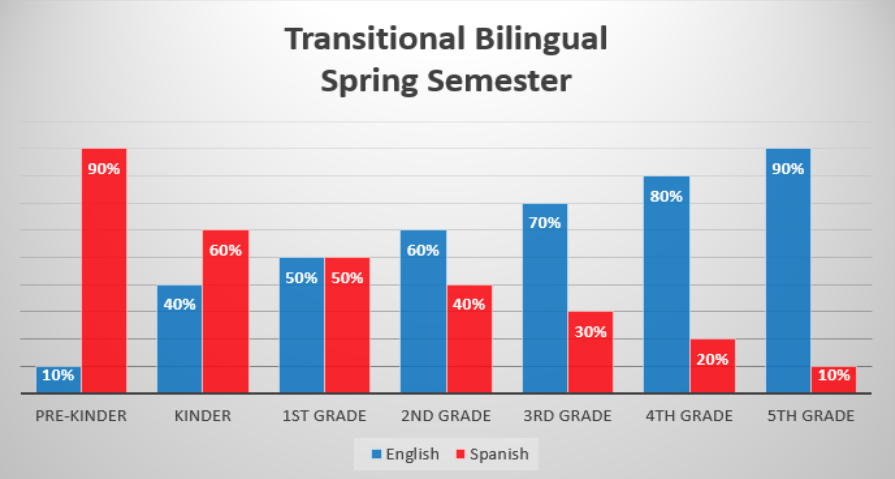Northside’s Transitional bilingual/early exit is a bilingual program model in which students identified as English learners are served in both English and another language and are prepared to meet reclassification criteria to be successful in English-only instruction not earlier than two or later than five years after the student enrolls in school. (§89.1210. Program Content and Design)
The Instructional Approach of this model provides instruction in literacy and academic content through the medium of the students’ primary language, along with instruction in English that targets second language development through academic content.
Transitional Bilingual Framework Graphs
The following graphs indicate the transitional bilingual framework, which dictate how much English (blue) and how much Spanish (red) language support children receive from PK through 5th grade.


Frequently Asked Questions about Transitional
Academic instruction is provided by teachers who:
- are proficient in the primary language of your child, as well as English; and
- are trained in second language acquisition methods and how to adapt instruction to meet the specific language needs of your child.
Research indicates that children who participate in a bilingual education program:
- build on a literacy foundation in their primary language to acquire stronger cognitive and academic skills in English;
- are more likely to develop a bicultural identity, become biliterate, and have higher self-esteem; and
- may use their bilingual skills to access competitive job opportunities in a global world
Yes, students who receive services in other programs, such as special education, 504, response to intervention, and gifted/talented or advanced academics, may also participate in the bilingual education program. The LPAC, in conjunction with other student service committees, meets to discuss and coordinate services based on the educational need of your child.
Your child will develop language and literacy skills in his/her primary language as a resource for acquiring English. He/she will develop reading, writing, listening, and speaking skills in English through the English Language Proficiency Standards (ELPS) in conjunction with grade level academic instruction in the Texas Essential Knowledge and Skills (TEKS) for all content areas, including language arts, math, science, and social studies. Your child’s teacher will be proficient in your child’s primary language and English and is specially trained to meet your child’s language needs. Instruction shall be designed to consider your child’s unique learning experiences, instill a positive identity, and honor the culture and experiences of your child.
Yes, mastery of the skills of listening, speaking, reading and writing in English is an expectation and is required in the bilingual education program.
Parents can support their child’s acquisition of English by providing opportunities at home to practice their primary language and English. Research shows the benefits of primary language development on second language development and the positive transfer of skills from one language to another.
- Reading and engaging in conversations with your child in your primary language, and English, to support development of your child’s oral language and literacy skills in the primary language and in English; and
- Encouraging your child to achieve by providing him/her a place to study and showing interest in his/her school work.
- Participating as a member of the Language Proficiency Assessment Committee (LPAC);
- Volunteering at your child’s school and supporting your child’s teacher in classroom activities; and
- Serving on school and district-based decision-making or other advisory committees.
Students in the Transitional Bilingual program will receive 90% of the instruction in Spanish starting in PreKinder and will gradually increase in English Language development.